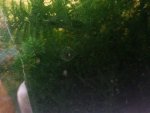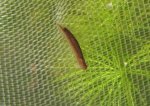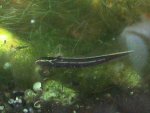Hello everybody, it’s time to introduce myself: I’m Herve, urodela lover for long time. I have currently only few species of amphibians: axolotl, Pleurodeles waltl, Typhlonectes natans, Pseudobranchus sp. and recently young Siren intermedia nettingi.
This said, this message is about my dwarf sirens.
A friend of mine acquired them for me in April 2014; they were apparently (sub?) adults, and I got them with me in December 2014. I suspect it is P. striatus, but unfortunately, I cannot be sure...
At the beginning of September 2015, I could see a smaller dwarf siren swimming after the largest one, obviously the male after the female. (except this "swimming race", I could not observe more of their breeding behavior).
And in 15th of September, I was lucky to see my first egg! :happy:
Then, I could see regularly either one new egg or a new hatched larvae. Eventually, the best way to save the larvae, was to collect the young larvae as soon as I saw them (after daily monitoring), and put in the same aquarium of the parents, but isolated in a transparent box with net on its side.
Below are some different stages:
Just hatched
Several days old
Weeks old
If I recall correctly, somewhen in December the parents stopped “producing”.
The collected larvae are still OK today, growing surely, but very slowly, and today they’re ranging from 1cm to about 5cm. They have such tiny mouth, that it is not always easy to find appropriate food. I manage with small Daphnia (or Moina sp?), and start to give them very small blood worm when I found some. In fact, I have also 1 or 2 larvae that are still alive and "free" with their parents, showing, that the parents are not eating them; but the disadvantage is that I'm not sure they find their "microfood" properly...
Having very short experience, it’s not very serious to raise conclusions, but at this stage, I think one of the key element for breeding is the day/night period (and its change with season). Open to discussion…
That’s all for now.
This said, this message is about my dwarf sirens.
A friend of mine acquired them for me in April 2014; they were apparently (sub?) adults, and I got them with me in December 2014. I suspect it is P. striatus, but unfortunately, I cannot be sure...
At the beginning of September 2015, I could see a smaller dwarf siren swimming after the largest one, obviously the male after the female. (except this "swimming race", I could not observe more of their breeding behavior).
And in 15th of September, I was lucky to see my first egg! :happy:
Then, I could see regularly either one new egg or a new hatched larvae. Eventually, the best way to save the larvae, was to collect the young larvae as soon as I saw them (after daily monitoring), and put in the same aquarium of the parents, but isolated in a transparent box with net on its side.
Below are some different stages:
Just hatched
Several days old
Weeks old
If I recall correctly, somewhen in December the parents stopped “producing”.
The collected larvae are still OK today, growing surely, but very slowly, and today they’re ranging from 1cm to about 5cm. They have such tiny mouth, that it is not always easy to find appropriate food. I manage with small Daphnia (or Moina sp?), and start to give them very small blood worm when I found some. In fact, I have also 1 or 2 larvae that are still alive and "free" with their parents, showing, that the parents are not eating them; but the disadvantage is that I'm not sure they find their "microfood" properly...
Having very short experience, it’s not very serious to raise conclusions, but at this stage, I think one of the key element for breeding is the day/night period (and its change with season). Open to discussion…
That’s all for now.





